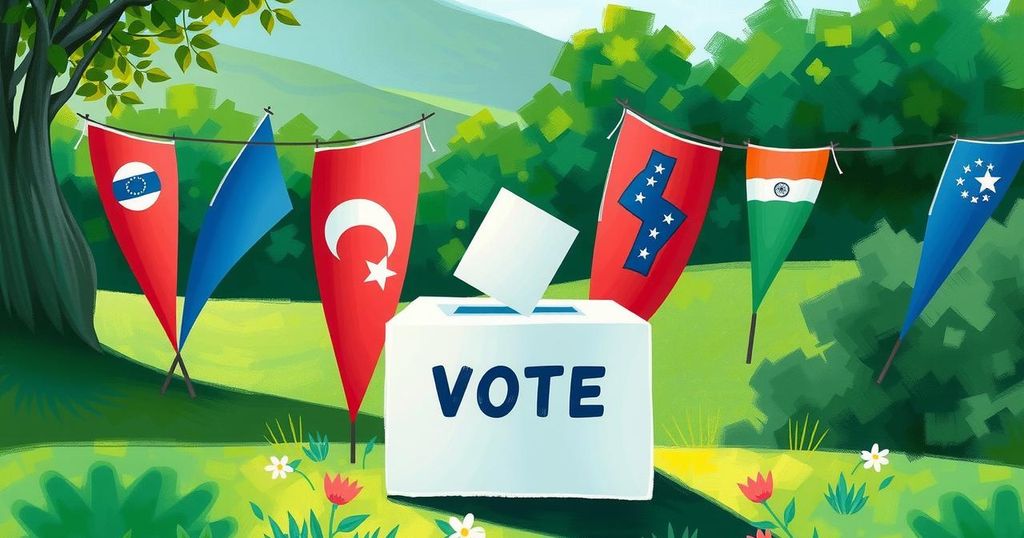Greenland held parliamentary elections on March 11th, where six parties competed for 31 seats in Inatsisartut. The election highlights issues of self-determination amidst U.S. influence, with local concerns about economic and social development at the forefront. Approximately 90% of voters oppose U.S. control, favoring autonomy and diverse international relations.
On March 11th, Greenlanders participated in a significant parliamentary election for the Inatsisartut, aiming to select their representatives. The outcome will influence Greenland’s future relations with both the Kingdom of Denmark and the United States. Polls opened at 09:00 and closed at 20:00 (local time). Prime Minister Múte Bourup Egede announced the election on February 4th, urging for unity amidst serious challenges facing the nation, stating, “It is time for an Inatsisartut election… This is not the time for internal division but for cooperation and unity for our country.”
The election is critical due to two primary issues: the influence of U.S. President Donald Trump regarding control over Greenland and an ongoing debate about self-government and independence from Denmark. Trump has expressed intentions to gain control over the island through various means and suggested that under U.S. rule, Greenland would experience significant development. Conversely, leaders in Nuuk and Copenhagen affirm that Greenland’s sovereignty and right to self-determination are paramount.
Additionally, discussions regarding Greenland’s self-governance have intensified, focusing on economic sustainability and independence from Danish governance, reflective of the historical struggle with Danish colonialism. Key local issues also dominate: economic growth, healthcare, education, housing, infrastructure, and security against challenges such as climate change.
Greenland is structured as a self-governed entity within the Kingdom of Denmark, with responsibilities dictated mainly by the 2009 Self-Government Act. The Inatsisartut, comprising thirty-one seats, is directly elected through a proportional representation system. The outgoing government is a coalition of the Inuit Ataqatigiit and Siumut parties, who have led since 2022.
With a population of 56,699, approximately 40,000 residents are eligible to vote in the current elections. The upcoming municipal and village council elections are slated for April 1, 2025. Greenlanders also elect representatives to the Danish parliament, with the most recent turnout reported at 47.8 percent during the Danish elections in November 2022.
Six political parties are contesting in this election: 1) Inuit Ataqatigiit (left-leaning, pro-independence), 2) Siumut (social democratic), 3) Naleraq (business-focused, pro-independence), 4) Demokraatit (social-liberal), 5) Atassut (liberal, pro-Union), and 6) Qulleq (newly formed, pro-independence). The projected distribution of parliamentary seats includes 11 seats for Inuit Ataqatigiit, 10 for Siumut, and smaller allocations for the remaining parties.
Recent polling analysis highlighted significant opposition to the U.S. taking control of Greenland, with nearly 90% of respondents opposed to such an outcome. This sentiment reflects a broader desire within Greenland to foster diverse international relations rather than becoming overly reliant on any single nation. According to researcher Ulrik Pram Gad, the Greenlandic populace seeks opportunities for collaboration without sacrificing its autonomy.
In summary, the recent parliamentary elections in Greenland signify a pivotal moment in the realm’s political landscape, as six parties vie for 31 seats in the Inatsisartut. The implications of U.S. influence and a desire for self-determination are central themes, with a notable preference among voters to maintain autonomy rather than submit to foreign control. The electoral outcomes will undoubtedly shape Greenland’s socio-economic and geopolitical trajectory moving forward.
Original Source: www.highnorthnews.com




